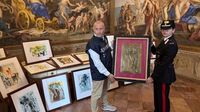The elegant halls of Parma’s Palazzo Tarasconi, a 16th-century cultural landmark in northern Italy, became the unlikely stage for a high-profile art scandal this week. On September 30, 2025, Italian art police—known for their dogged pursuit of cultural crime—seized 21 artworks purportedly by the legendary surrealist Salvador Dalí. The works, which included tapestries, drawings, and engravings, were part of the exhibition "Salvador Dalí, tra arte e mito" ("Salvador Dalí, Between Art and Myth"), which had already spent months on display in Rome before opening in Parma just days earlier.
The dramatic intervention followed a tip-off from the Fundación Gala - Salvador Dalí, the non-profit foundation established by Dalí himself in 1983 to “promote, foster, disseminate, enhance, and defend Dalí’s world worldwide,” as stated on the foundation’s website. The foundation, based in Figueres, Catalonia, had noticed anomalies in several of the works while the show was still in Rome and alerted Italy’s famed Carabinieri art squad, which specializes in cultural heritage protection.
According to The Associated Press, the foundation’s suspicions were first raised back in January 2025 during a routine inspection by Rome’s Carabinieri art unit at the Museo Storico della Fanteria, where the exhibition was then being held. Diego Poglio, the senior officer leading the investigation, told The Guardian, “During the inspection, the kind we generally do at museums, something seemed to be amiss.” Poglio elaborated that the exhibition featured only lithographs, posters, and drawings, with a smattering of statues and other objects, but conspicuously lacked any paintings or major works. “It was difficult to understand why someone would want to organise an exhibition of such low-value works,” he remarked.
The absence of high-value pieces and the lack of contact with the Dalí Foundation—an unusual omission for any major exhibition of the artist’s work—deepened suspicions. The police sent photographs of the questionable pieces to the foundation, which agreed that “something didn’t add up” and promptly dispatched a team of experts to Rome. Their assessment confirmed the presence of ambiguities, prompting Rome prosecutors to order the seizure of the 21 suspect works.
On the morning of October 1, 2025, armed with a judge’s warrant, officers from the Carabinieri Cultural Heritage Protection Command entered the Palazzo Tarasconi and confiscated the disputed artworks. The pieces, which included tapestries, drawings, and engravings, were removed for further technical and scientific investigation to determine their authenticity. As of the latest reports, the investigation remains ongoing and no individuals have yet been formally accused of wrongdoing. “Now we will proceed with the necessary technical and scientific investigations to determine whether the works are authentic or not,” said Poglio, emphasizing the preliminary nature of the probe.
The incident has once again cast a spotlight on the global problem of art forgery—a phenomenon that has dogged the world’s most celebrated artists for decades. According to ArtNews, Dalí ranks among the most-forged artists worldwide, alongside Pablo Picasso and Amadeo Modigliani. The Fine Arts Expert Institute estimates that “over 50% of art circulating on the market may be forged or misattributed,” a staggering figure that underscores the scale of the problem.
Italy’s art police are no strangers to such cases. In February 2025, officers in Rome uncovered a clandestine workshop producing fake paintings by Picasso and Rembrandt, which were being sold online. That bust came just months after authorities dismantled a Europe-wide forgery network suspected of producing replicas of works by Banksy, Picasso, Andy Warhol, and Gustav Klimt. Often, as Poglio noted, these forgeries only come to light when they are displayed at prominent museums or galleries, sometimes by organizers acting in good faith. “Many of those behind the exhibitions act in good faith,” he explained. “That being said, we must always be careful—those in charge of the scientific curation must always conduct thorough checks on authenticity before displaying the works.”
The Palazzo Tarasconi, with its storied history as a hub of fine art and culture, now finds itself at the center of a cautionary tale. The building, which has hosted a variety of exhibitions over the years, was chosen for its reputation and grandeur. Yet, as the case demonstrates, even the most prestigious venues are not immune to the risks posed by counterfeit art.
Salvador Dalí, born in Spain in 1904 to a Catholic mother and an atheist father, drew on a rich tapestry of influences to develop his unique surrealist style. According to the Dalí Museum, “From Montreal, London and Spain to Tokyo, Venice and the United States, Dalí’s indescribable talent and extraordinary creativity has become a universal language of fearlessness, inspiration and relentless self-expression.” It is perhaps this very universality—and the immense commercial value attached to Dalí’s name—that has made him such a frequent target for forgers.
The current investigation into the Parma exhibition is just the latest chapter in a long-running battle between law enforcement and art counterfeiters. The Italian authorities, for their part, have stressed the importance of scientific curation and authenticity checks before any major exhibition. As Poglio put it, “We’re seeing a significant presence of fakes in the market, especially in contemporary art. It is a global phenomenon.”
For now, the 21 seized works remain in the custody of Italian authorities, their fate to be determined by forensic analysis and expert review. The organizers of the exhibition have not been accused of intentional wrongdoing, and the investigation is focused on establishing the true origin of the pieces. As the art world waits for answers, the scandal serves as a stark reminder of the ongoing challenges facing museums, collectors, and the public alike in distinguishing genuine masterpieces from clever imitations.
With the investigation still in its early stages, one thing is abundantly clear: the allure of Dalí’s genius continues to inspire not just artists and admirers, but also those who would seek to profit from his legacy in less-than-honest ways. The episode at Parma’s Palazzo Tarasconi is a vivid illustration of the high stakes—and high drama—that often surround the world of fine art.






